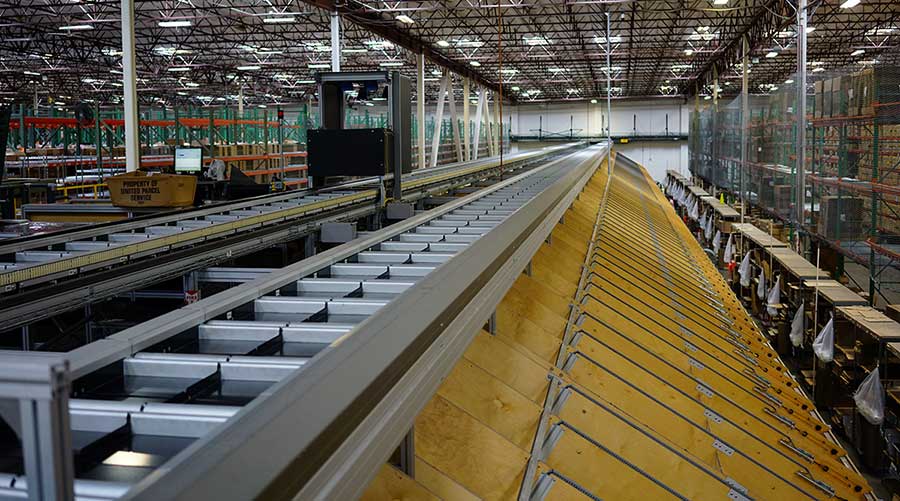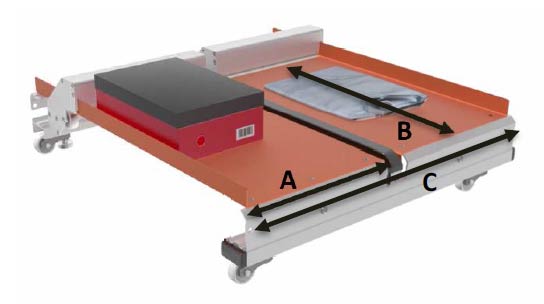Push Tray Sorters: Use Case, Cost, and Other Considerations

For years, crossbelt sorters and tilt tray sorters were the best and only options for many companies’ product ranges. Their only limitation being that they had to leave out only the smallest of items and non-conveyables.
Many warehouses and distribution centers had become accustomed to how expensive these systems were and the fact that they took up a significant amount of space. This meant that only the largest companies could afford them, even if they had to design whole facilities around the space necessary for these types of sorters.
If you’ve lacked floor space, capital, or cost justification in the past, or if you have an aging sorter, you maybe inclined to simply replace it with similar technology that you are already familiar with. While this may be the easiest path forward, taking the time to do your due diligence now to compare your options will allow you to select the right choice for your operation. The push tray sorter, for example, may provide the throughput, reduced space, and cost justification you are looking for.
Now let’s say that you’re an apparel or footwear company looking for your next unit sorter. While you have an aging crossbelt sorter, is that still the best technology for you? Maybe not. If your operation will never sort an item over 15 lbs., then why are you considering a sorter that was designed to handle 75 lbs.? This is where the push tray sorter can really enhance operational efficiency without sacrificing design.
What is a Push Tray Sorter?
Companies in Europe were the first early adopters of the pushtray and now it is quickly becoming popular among companies in the United States and around the world for its simple, space saving design, versatility, and cost effectiveness.
This style of unit sorter uses a mechanically driven push bar to provide a positive divert and “push” the product gently off the tray. This positive divert allows this style of sorter to sort both light polybags and heavy cartons on the same sorter at the same time, in addition to providing the flexibility to sort items as small and light as a business card or as non-conveyable and hard to handle as a tube of lipstick.
For many operations, the choice to switch from manual sorting to automated sortation was put off for as long as possible—sometimes forever—due to the large upfront cost of a traditional crossbelt and tilt tray sorters.
The complexity and cost of these systems is driven by the fact that a traditional crossbelt sorter requires each tray to have its own motor, as well as a central drive system to “spin” the sorter. The large weight capacity of a crossbelt sorter requires a welded steel frame and large support structure designed for the situation where every carrier is filled with heavy product
Cost Efficiency Of Push Tray Sorters
In comparison, the extrusion frame of today’s pushtrays, designed for apparel, footwear, and other consumer goods, are lightweight and simple. These trays rely on fixed, electrically activated solenoids for activation instead of motors, the entire system is drastically less complex.
The graph below illustrates the difference this complexity has on price per destination with a push-tray sorter being about 50% less per destination than comparable crossbelt and tilt tray sorters. .

This cost efficiency enables a wider range of companies to achieve a quick ROI allowing them to increase throughput long before a tilt tray or crossbelt sorter can achieve, as well as increasing customer service and satisfaction levels.
Push Tray Sorters Offer Space Savings
When considering your next unit sorter, the square footage of the system also needs to be a key consideration, especially in today’s market of limited available warehouse space. According to CBRE, one of the worldwide leaders in real-estate services:
“Availability of U.S. industrial real estate dipped to 7.2 percent in the second quarter [of 2018], the lowest point since 2000. The streak of 32 consecutive quarters of declining availability is the longest since CBRE started tracking the data in 1988.”
Therefore, a system that utilizes space efficiently and effectively should be your priority, and will further contribute to the ROI of the system.
The push tray sorter is not the only option for a dense sorting solution, it is however one of the best options for handling individual items like poly-bags and cartons on the same sorter. This can be achieved with a push sorter because, unlike crossbelts and tilt trays that require destinations as large as 2 meters wide, the push-tray sorter can discharge into as small as a 24-inch destination.
This makes it ideal for fitting large numbers of destinations into existing facilities, and for the inevitable consumer shift towards e-commerce, which forces smaller average order sizes and requires larger numbers of destinations.

Push Tray Sortation Throughput and Volume
While product type, cost, and space requirements are all important considerations, none of those matter if the sorter cannot keep up with your throughput needs or with the rest of your system.
For true high-volume systems where 20,000-25,000 items/hour throughputs with >25 lb. cartons are required from one sorter, the tilt tray or crossbelt sorter still reigns king. But for all other operations, you have other options.
With the reduced space between carriers, the pushtray can achieve rates of up to 9,600 items/hour from a single induction area with a single pushtray, and up to 13,300 items/hour with a twin-pushtray.
The image below shows a twin push tray. This system allows each carrier in the sorter to be used for two smaller items (A and B), or one larger item (C).

The ability to add a second induction area to the system bumps the total throughput of a push tray sorter up to 19,600 trays/hour, or enough for all but the highest throughput operations.
Adding Push Tray Sorters To Your Operation
None of this is to say that other types of sortation equipment are not valuable or worth consideration when choosing new equipment for your facility. But thinking that you must replace like with like is not an efficient way of doing business, and can lead to wasted capital and less efficiency.
When your operation is looking for its next unit sorter, consider whether a crossbelt or tilt tray sorter is really the best option, or whether a push-tray sorter could be a better fit. If you are handling 50+ lb. cartons regularly, or rates of at least 20,000 items/hour then the tilt tray or crossbelt sorter still should be at the top of your list, but if you typically handle lighter product, non-conveyables, or have a tight footprint within which to fit the sorter, then a push-tray may make for an alternative.
Editorial Note: This article was contributed by Scott Eisenberg, an account manager for Eurosort—a manufacturer of high-speed sortation systems. Though we agree with the opinion shared, we think that it is important to note that determining the best technology for your current and future business is what Conveyco does best. Being manufacturer-neutral and having over 40 years of working relationships with manufacturers around the world, Conveyco can help you analyze and determine the best technology and manufacturer for your exact business needs.





